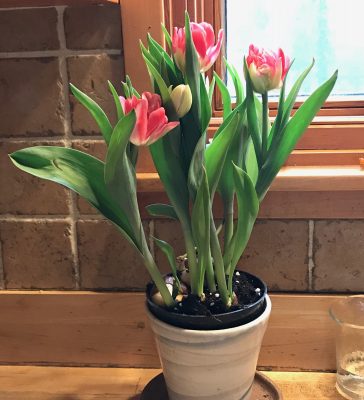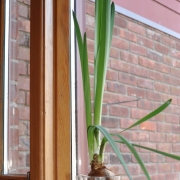An Early Spring
It could be spring. Now. Indoors, with the sweet fragrance from a flowerpot of pastel colored hyacinths and other spring-flowering bulbs. All it takes is a little bit of trickery. The bulbs don’t have to wait till spring.
Knowing what a bulb is helps understand the trickery. But first: All that we commonly call a “bulb” is not, in fact, a bulb botanically speaking. To conjure up an image of a true bulb, picture a stem that’s been telescoped down from a couple of feet or more long to a fraction of an inch. All the leaves on that bulb also move down and closer together. The leaves, except the innermost ones, are thick and juicy, the better to store both moisture and food reserves. Near the center of the bulb is a sleeping flower bud.
Hyacinths, daffodils, and tulips are true bulbs.
Though often called a bulb, crocus is an example of a “corm.” A corm is also a short stem, in this case a short fat stem which provides storage for food reserves for winter and to fuel early spring growth.
Forcing a bulb, real or not, to flower early, indoors is, in many ways, just like forcing a cut branch of dogwood or plum to flower early, indoors. Daffodil, hyacinth, tulip, crocus, dogwood, and plum stems all enter winter with flower buds sleeping within.
All these stems of cold-climate plants are savvy enough not to start growing in the dead of winter, even after a freak warm spell. They do this by marking time, counting hours and days when temperatures are between about 30 and 45 degrees Fahrenheit, that is, cool but not frigid. Once sufficient hours have accumulated, their chilling “bank” has been filled, warmth can awaken a stem, whether its a dogwood branch or a daffodil bulb.
The first step in forcing a bulb is to get it to grow roots by planting it in a pot of soil or stones, or to suspend the bulb above water with only its base in the drink. A bulb’s roots, like the roots of other plants, grow whenever soil temperatures are above 40°F., so they can be in place and ready to support leaves and flowers when spring comes.
In time, typically 6 to 8 weeks, which varies with the type and variety of bulb, roots will grow and the the winter chilling requirement will be satisfied. Once the chilling “bank” has been filled, growth can begin. A well-grown, spring-flowering bulb comes packed with a flowerbud-in-waiting . . . waiting, that is, for a chilling period to break its dormancy and then sufficient warmth to allow growth. The larger the bulb, the more flowers-in-waiting.
Keeping a potted bulb cool at this point is useful for staggering flowering for multiple pots of bulbs or delaying flowering for a specific date, such as someone’s birthday.
When ready to enjoy the flowers, don’t just bring the pot into a hot room. They would blast open and collapse. The plants, at this point, need gradually increasing warmth, and enough light to draw out a sturdy flower stalk. Forcing bulbs to blossom out of season demands a certain amount of artistry in addition to science.
If you want flowers and want them now, and haven’t prepared bulbs ahead of time, you still have some options. Purchasing pre-chilled bulbs is one option.
The other option is to bypass the whole chilling rigamarole and force Paperwhite narcissi. These bulbs hail from perennially warm climes and will bloom without any prior chilling. All that’s needed is to pot them up and wait as long as it takes for the fragrant, white blossoms to unfold. To stagger their blooms, pot them up sequentially; lack of water keeps them dormant.
When the flower on a forced bulb has wilted and the show is over, the usual next home for the bulb is the compost pile. If the plant has been planted in soil, and if the emerging leaves can be kept growing in very bright light for many weeks, sufficient energy can be garnered keep the bulb alive through the following dormant season. Then plant the bulb outdoors this autumn and it should flower again — in a few springs hence, once it garners enough energy to also make flower buds.




